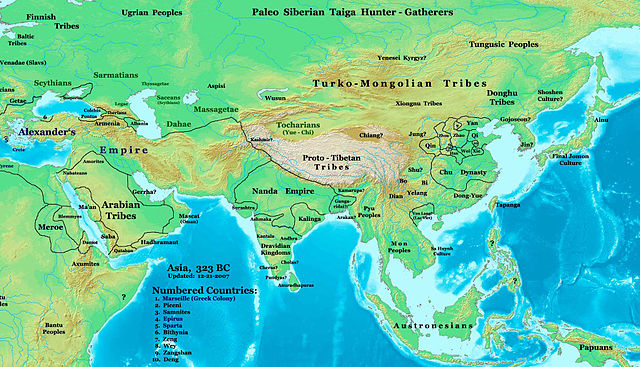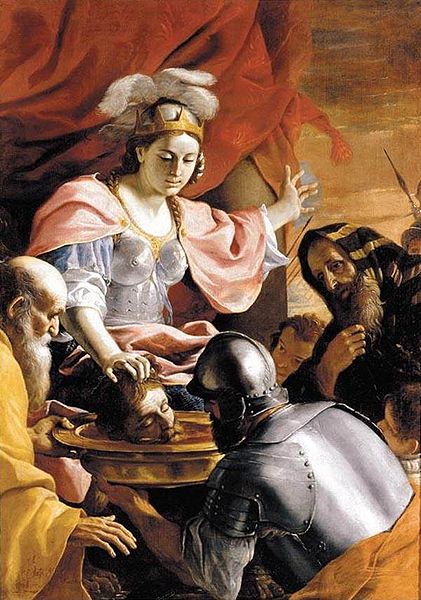
| MASSAGETAE
Asia in 323 BC, showing the Massagetae located in Central Asia The Massagetae, or Massageteans, were an ancient Eastern Iranian nomadic tribal confederation, who inhabited the steppes of Central Asia, north-east of the Caspian Sea in modern Turkmenistan, western Uzbekistan, and southern Kazakhstan. They were part of the wider Scythian cultures.
The Massagetae are known primarily from the writings of Herodotus who described the Massagetae as living on a sizeable portion of the great plain east of the Caspian Sea. He several times refers to them as living "beyond the River Araxes", which flows through the Caucasus and into the west Caspian. Scholars have offered various explanations for this anomaly. For example, Herodotus may have confused two or more rivers, as he had limited and frequently indirect knowledge of geography.
According to Greek and Roman scholars, the Massagetae were neighboured by the Aspasioi (possibly the Asvaka) to the north, the Scythians and the Dahae to the west, and the Issedones (possibly the Wusun) to the east. Sogdia (Khorasan) lay to the south.
Possible
connections to other ancient peoples :
Ammianus Marcellinus considered the Alans to be the former Massagetae. At the close of the 4th century CE, Claudian (the court poet of Emperor Honorius and Stilicho) wrote of Alans and Massagetae in the same breath: "the Massagetes who cruelly wound their horses that they may drink their blood, the Alans who break the ice and drink the waters of Maeotis' lake" (In Rufinem).
Medieval
writers :
Queen Tomyris of the Massagetae, receiving the head of Cyrus the Great, circa 530 BCE (18th century painting) Evagrius Scholasticus (Ecclesiastical History. Book 3. Ch. II.): "and in Thrace, by the inroads of the Huns, formerly known by the name of Massagetae, who crossed the Ister without opposition".
A 9th century work by Rabanus Maurus, De Universo, states: "The Massagetae are in origin from the tribe of the Scythians, and are called Massagetae, as if heavy, that is, strong Getae." In Central Asian languages such as Middle Persian and Avestan, the prefix massa means "great", "heavy", or "strong".
Modern
writers :
Many scholars have suggested that the Massagetae were related to the Getae of ancient Eastern Europe.
Tadeusz Sulimirski notes that the Sacae also invaded parts of Northern India. Weer Rajendra Rishi, an Indian linguist has identified linguistic affinities between Indian and Central Asian languages, which further lends credence to the possibility of historical Sacae influence in Northern India.
According to Guive Mirfendereski at the Circle of Ancient Iranian Studies (CAIS), the Massagetae are synonymous with the Saka haumavarga of South Asian historiography.
Rüdiger Schmitt, notes Ptolemy's conflicting reports concerning the Massagetae. First, localizing them near Margiana, then later Ptolemy calls them a tribe of the Saka in the vicinity of the Hindu Kush. Schmitt, who states these terms are not relevant for ancient times, also notes that Byzantine authors used the word Massagetae as an antiquated term for Huns, Turks and Tatars.
Culture
:
According to Herodotus :
[1.215] In their dress and mode of living the Massagetae resemble the Scythians. They fight both on horseback and on foot, neither method is strange to them: they use bows and lances, but their favourite weapon is the battle-axe. Their arms are all either of gold or brass. For their spear-points, and arrow-heads, and for their battle-axes, they make use of brass; for head-gear, belts, and girdles, of gold. So too with the caparison of their horses, they give them breastplates of brass, but employ gold about the reins, the bit, and the cheek-plates. They use neither iron nor silver, having none in their country; but they have brass and gold in abundance.
[1.216] The following are some of their customs; – Each man has but one wife, yet all the wives are held in common; for this is a custom of the Massagetae and not of the Scythians, as the Greeks wrongly say. Human life does not come to its natural close with this people; but when a man grows very old, all his kinsfolk collect together and offer him up in sacrifice; offering at the same time some cattle also. After the sacrifice they boil the flesh and feast on it; and those who thus end their days are reckoned the happiest. If a man dies of disease they do not eat him, but bury him in the ground, bewailing his ill-fortune that he did not come to be sacrificed. They sow no grain, but live on their herds, and on fish, of which there is great plenty in the Araxes River. Milk is what they chiefly drink. The only god they worship is the sun, and to him they offer the horse in sacrifice; under the notion of giving to the swiftest of the gods the swiftest of all mortal creatures.
History :
Queen Tomyris of the Massagetae receiving the head of Cyrus the Great. 1670 - 1672 painting Concerning the death of Cyrus the Great of Persia by the Massagetae, Herodotus writes :
[1.201] When Cyrus had achieved the conquest of the Babylonians, he conceived the desire of bringing the Massagetae under his dominion. Now the Massagetae are said to be a great and warlike nation, dwelling eastward, toward the rising of the sun, beyond the river Araxes, and opposite the Issedones. By many they are regarded as a Scythian race.
[1.211] Cyrus advanced a day's journey into Massagetan territory from the Araxes... Many of the Massagetae were killed, but even more taken prisoner, including Queen Tomyris's son, who was commander of the army and whose name was Spargapises.
[1.214] Tomyris mustered all her forces and engaged Cyrus in battle. I consider this to have been the fiercest battle between non-Greeks that there has ever been.... They fought at close quarters for a long time, and neither side would give way, until eventually the Massagetae gained the upper hand. Most of the Persian army was wiped out there, and Cyrus himself died too.
Source :
https://en.wikipedia.org/ |


